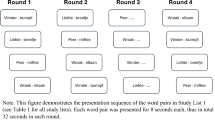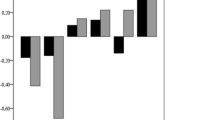Abstract
With funding from the United States National Science Foundation, 30 historical short stories designed to teach science content and draw students’ attention to the nature of science (NOS) have been created for post-secondary introductory astronomy, biology, chemistry, geology, and physics courses. The project rationale, story development and structure, and freely available stories at the project website are presented.
Similar content being viewed by others
References
Abd-El-Khalick, F. (1999). Teaching science with history. The Science Teacher, 66(9), 18–22.
Abd-El-Khalick, F., Bell, R. L., & Lederman, N. G. (1998). The nature of science and instructional practice: Making the unnatural natural. Science Education, 82(4), 417–436.
Abd-El-Khalick, F., & Lederman, N. G. (2000a). The influence of history of science courses on students’ views of nature of science. Journal of Research in Science Teaching, 37(10), 1057–1095.
Abd-El-Khalick, F., & Lederman, N. G. (2000b). Improving science teachers’ conceptions of nature of science: A critical review of the literature. International Journal of Science Education, 22(7), 665–701.
Allchin, D. (2003). Scientific myth-conceptions. Science Education, 87(3), 329–351.
American Association for the Advancement of Science. (1989). Project 2061: Science for all Americans. Washington, DC: AAAS.
American Association for the Advancement of Science. (1993). Benchmarks for science literacy. New York: Oxford University Press.
Association for Science Education. (1981). Education through science: An ASE policy statement. Hatfield: ASE.
Bishop, B., & Anderson, C. (1990). Student conception of natural selection and its role in evolution. Journal of Research in Science Teaching, 27(5), 415–427.
Bransford, J. D., Brown, A. L., & Cocking, R. R. (Eds.). (2000). How people learn: Brain, mind, experience, and school. Washington, DC: National Academy Press.
Brickhouse, N. W., Dagher, Z. R., Letts, W. J., & Shipman, H. L. (2000). Diversity of students’ views about evidence, theory, and the interface between science and religion in an astronomy course. Journal of Research in Science Teaching, 37(4), 340–362.
Clough, M. P. (1995). Longitudinal understanding of the nature of science as facilitated by an introductory high school biology course. In Proceedings of the third international history, philosophy, and science teaching conference (pp. 212–221). Minneapolis: University of Minnesota.
Clough, M. P. (1997). Strategies and activities for initiating and maintaining pressure on students’ naive views concerning the nature of science. Interchange, 28(2–3), 191–204.
Clough, M. P. (2004). The nature of science: Understanding how the “Game” of science is played. In W. Jeff (Ed.), The game of science education (pp. 198–227). Boston, MA: Allyn and Bacon.
Clough, M. P. (2006). Learners’ responses to the demands of conceptual change: Considerations for effective nature of science instruction. Science & Education, 15(5), 463–494.
Clough, M. P., Herman, B. C., & Smith, J. A. R. (2010). Seamlessly teaching science content and the nature of science. In Association for Science Teacher Education (ASTE) National Conference, Sacramento, CA, 14–16 Jan.
Collette, A. T., & Chiappetta, E. L. (1984). Science instruction in the middle and secondary schools. St. Louis: Times Mirror/Mosby.
Conant, J. B. (1957). Harvard case histories in experimental science. Cambridge: Harvard University Press.
Cromer, A. (1993). Uncommon sense: The heretical nature of science. New York: Oxford University Press.
DeBoer, G. (1991). A history of ideas in science education: Implications for practice. New York: Teachers College Press.
Driver, R., Leach, J., Millar, R., & Scott, P. (1996). Young people’s images of science. Buckingham: Open University Press.
Durant, J. R., Evans, G. A., & Thomas, G. P. (1989). The public understanding of science. Nature, 340, 11–14.
Duschl, R. A. (1990). Restructuring science education: The importance of theories and their development. New York: Teachers College Press.
Eccles, J. (2005). Why women shy away from careers in science and math. U of M News Service, available at http://www.umich.edu/news/index.html?Releases/2005/Apr05/r041405, retrieved 21 June 2009.
Egan, K. (1978). What is a plot? New Literary History, 9, 455–473.
Gilovich, T. (1991). How we know what isn’t so. New York: Free Press.
Hagen, J., Allchin, D., & Singer, F. (1996). Doing biology. New York, NY: HarperCollins.
Heilbron, J. L. (2002). History in science education, with cautionary tales about the agreement of measurement and theory. Science & Education, 11(4), 321–331.
Howe, E. (2003). Using the history of research on sickle-cell anemia to affect preservice teachers’ conceptions of the nature of science. Unpublished doctoral dissertation, Western Michigan University, Kalamazoo, MI.
Irwin, A. R. (2000). Historical case studies: Teaching the nature of science in context. Science Education, 84(1), 5–26.
Jacoby, B. A., & Spargo, P. E. (1989). Ptolemy revisited? The existence of a mild instrumentalism in some selected high school physical science textbooks. Interchange, 20(1), 33–53.
Jahn, M. (2005). Narratology: A guide to the theory of narrative, University of Cologne, Cologne, available at http://www.uni-koeln.de/~ame02/pppn.htm#N1, retrieved 1 Oct 2009.
James, W. (1907). ‘The social value of the college-bred’, Address delivered at a meeting of the Association of American Alumnae at Radcliff College, 7 Nov, available at http://www.des.emory.edu/mfp/jaCollegeBred.html, retrieved 21 June 2009.
Johnson, R. L., & Peeples, E. E. (1987). The role of scientific understanding in college. The American Biology Teacher, 49, 93–96.
Klopfer, L. E., & Cooley, W. W. (1963). The history of science cases for high schools in the development of student understanding of science and scientists. Journal of Research in Science Teaching, 1(1), 33–47.
Kruse, J. W., Clough, M. P., Olson, J. K., & Colbert, J. (2009). Student and instructor reaction to the use of historical short stories in a post-secondary introductory biology course. Paper presented at the 10th International History, Philosophy of Science in Science Teaching (IHPST) Conference, Notre Dame, IN, 24–28 June.
Kuhn, T. S. (1970). The structure of scientific revolutions. Chicago: University of Chicago Press.
Lakin, S., & Wellington, J. (1994). Who will teach the ‘nature of science’?: Teachers’ views of science and their implications for science education. International Journal of Science Education, 16(2), 175–190.
Lederman, N. G. (1992). Students’ and teachers’ conceptions of the nature of science: A review of the research. Journal of Research in Science Teaching, 29(4), 331–359.
Lederman, N. G. (1998). ‘The state of science education: subject matter without context. Electronic Journal of Science Education, 3(2), available at http://www.unr.edu/homepage/jcannon/ejse/lederman.html, retrieved 21 June 2009.
Leite, L. (2002). History of science in science education: Development and validation of a checklist for analysing the historical content of science textbooks. Science & Education, 11(4), 333–359.
Matthews, M. R. (1989). A role for history and philosophy in science teaching. Interchange, 20(2), 3–15.
Matthews, M. (1994). Science teaching: The role of history and philosophy of science. New York, NY: Routledge.
McComas, W. F., Clough, M. P., & Almazroa, H. (1998). The role and character of the nature of science in science education. Science & Education, 7(6), 511–532.
McComas, W. F., & Olson, J. K. (1998). The nature of science in international standards documents. In W. F. McComas (Ed.), The nature of science in science education: Rationales and strategies (pp. 41–52). Dordrecht, The Netherlands: Kluwer Academic Publishers.
Metz, D., Klassen, S., McMillan, B., Clough, M., & Olson, J. (2007). Building a foundation for the use of historical narratives. Science & Education, 16(3–5), 313–334.
Millar, R., & Wynne, B. (1988). Public understanding of science: From contents to processes. International Journal of Science Education, 10(4), 388–398.
Miller, J. D. (1983). Scientific literacy: A conceptual and empirical review. Daedalus, 112(2), 29–48.
Miller, J. D. (1987) Scientific literacy in the United States. In the Ciba foundation conference program, communicating science to the public (pp. 19–40). Chichester: John Wiley & Sons.
Munby, H. (1976). Some implications of language in science education. Science Education, 60(1), 115–124.
National Assessment of Educational Progress. (1989). Science objectives. Princeton: Author.
National Research Council. (1996). National science education standards. Washington, DC: National Academy Press.
National Science Board. (2002). Science and engineering indicators 2002. Arlington, VA: National Science Foundation.
National Science Teachers Association. (1982). Science-technology-society: Science education for the 1980’s. Washington, DC: An NSTA Position Statement, NSTA.
National Science Teachers Association. (2000). NSTA position statement—Nature of science. Washington, DC: NSTA, available at http://www.nsta.org/about/positions/natureofscience.aspx, retrieved 27 July 2010.
Olson, J. K., & Clough, M. P. (2001). Secondary science teachers’ implementation practices following a course emphasizing contextualized & decontextualized nature of science instruction. Paper presented at the 6th International History, Philosophy & Science Teaching (IHPST) Conference with the History of Science Society, Denver, CO, 7–11 Nov.
Olson, J. K., & Clough, M. P. (2007). Undergraduates’ NOS conceptions and the role of historical narratives: A very tangled web. Paper presented at the 9th International History, Philosophy of Science in Science Teaching (IHPST) Conference, Calgary, Canada, 24–27 June.
Postman, N. (1995). The end of education: Redefining the value of school. New York: Vintage.
Prince, G. (1973). A grammar of stories: An introduction. The Hague: Mouton.
Rowe, M. B., & Holland, C. (1990). The uncommon common sense of science. In M. B. Row (Ed.), What research says to the science teacher, volume six, the process of knowing (pp. 87–97). Washington, DC: National Science Teachers Association.
Rudge, D. W. (2000). Does being wrong make kettlewell wrong for science teaching? Journal of Biological Education, 35(1), 5–11.
Rudolph, J. L. (2000). Reconsidering the ‘nature of science’ as a curriculum component. Journal of Curriculum Studies, 32(3), 403–419.
Rudolph, J. L. (2007). An inconvenient truth about science education. Teachers College Record, http://www.tcrecord.org, ID Number: 13216, Date Accessed: 9/26/2007.
Rudolph, J. L., & Stewart, J. (1998). Evolution and the nature of science: On the historical discord and its implications for education. Journal of Research in Science Teaching, 35(10), 1069–1089.
Rutledge, M., & Warden, M. (2000). Evolutionary theory, the nature of science & high school biology teachers: Critical relationships. The American Biology Teacher, 62(1), 123–131.
Ryan, A. G., & Aikenhead, G. S. (1992). Students’ preconceptions about the epistemology of science. Science Education, 76(6), 559–580.
Ryder, J., Leach, J., & Driver, R. (1999). Undergraduate science students’ images of science. Journal of Research in Science Teaching, 36(2), 201–220.
Schaefer, J. P. (1990). Introduction. In S. Tobias (Ed.), They’re not dumb, they’re different: Stalking the second tier. Tucson: Research Corporation.
Scharmann, L. C., & Harris, W. M. (1992). Teaching evolution: Understanding and applying the nature of science. Journal of Research in Science Teaching, 29, 375–388.
Seymour, E., & Hewitt, N. M. (1997). Talking about leaving: Why undergraduates leave the sciences. Westview: Boulder.
Shahn, E. (1988). On scientific literacy. Educational Philosophy and Theory, 20(2), 42–52.
Shamos, M. H. (1995). The myth of scientific literacy. New Brunswick, NJ: Rutgers University Press.
Stinner, A., McMillan, B. A., Metz, D., Jilek, J. M., & Klassen, S. (2003). The renewal of case studies in science education. Science & Education, 12(7), 617–643.
Tao, P. K. (2003). Eliciting and developing junior secondary students’ understanding of the nature of science through a peer collaboration instruction in science stories. International Journal of Science Education, 25(2), 147–171.
Tobias, S. (1990). They’re not dumb, they’re different: Stalking the second tier. Tucson: Research Corporation.
Trani, R. (2004). I won’t teach evolution: It’s against my religion. The American Biology Teacher, 66(6), 419–427.
Vanderlinden, D. W. (2007). Teaching the content and context of science: The effect of using historical narratives to teach the nature of science and science content in an undergraduate introductory geology course. Unpublished Doctoral Dissertation, Iowa State University, Ames, IA.
Williams, B., Clough, M. P., Stanley, M., & Colbert, J. T. (2010). Creativity and discovery: The work of Gregor Mendel. Available at http://www.storybehindthescience.org/biology.html, retrieved 29 July 2010.
Wolpert, L. (1992). The unnatural nature of science. Cambridge, MA: Harvard University Press.
Ziman, J. (1991). Public understanding of science. Science, Technology, and Human Values, 16(1), 99–105.
Acknowledgments
Partial support for this work was provided by the National Science Foundation’s Course Curriculum, and Laboratory Improvement (CCLI) program under Award No. 0618446. Any opinions, findings, and conclusions or recommendations expressed in this material are those of the authors and do not necessarily reflect the views of the National Science Foundation.
Author information
Authors and Affiliations
Corresponding author
Rights and permissions
About this article
Cite this article
Clough, M.P. The Story Behind the Science: Bringing Science and Scientists to Life in Post-Secondary Science Education. Sci & Educ 20, 701–717 (2011). https://doi.org/10.1007/s11191-010-9310-7
Published:
Issue Date:
DOI: https://doi.org/10.1007/s11191-010-9310-7




